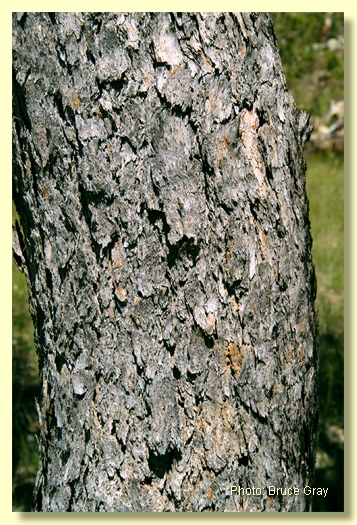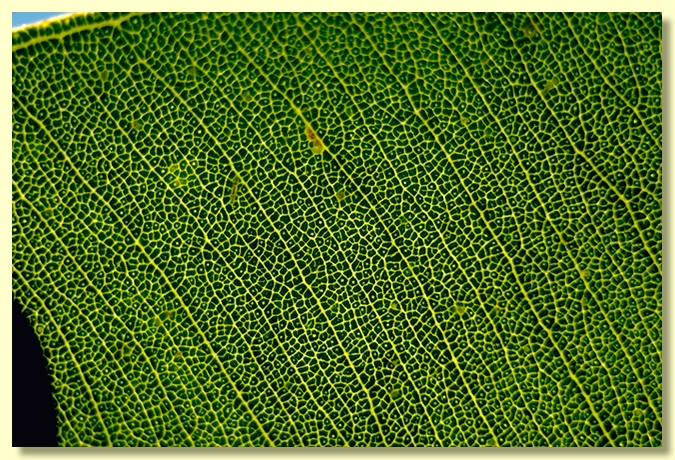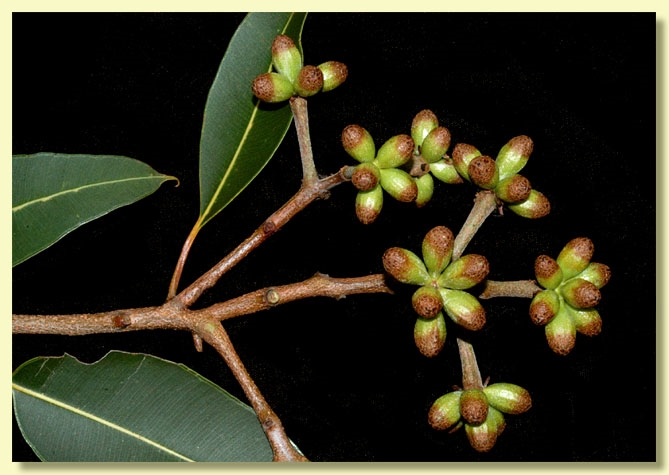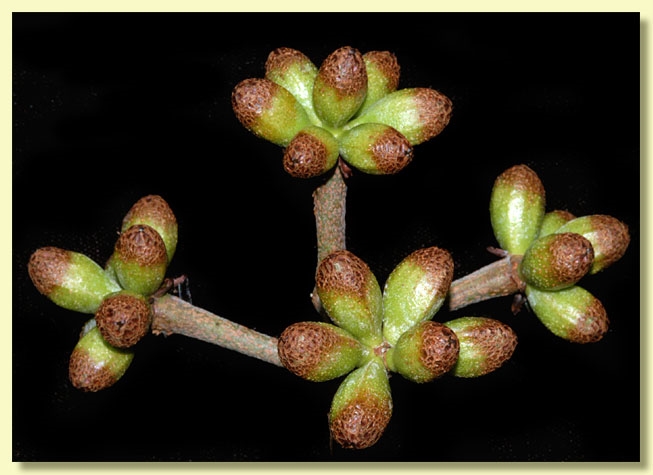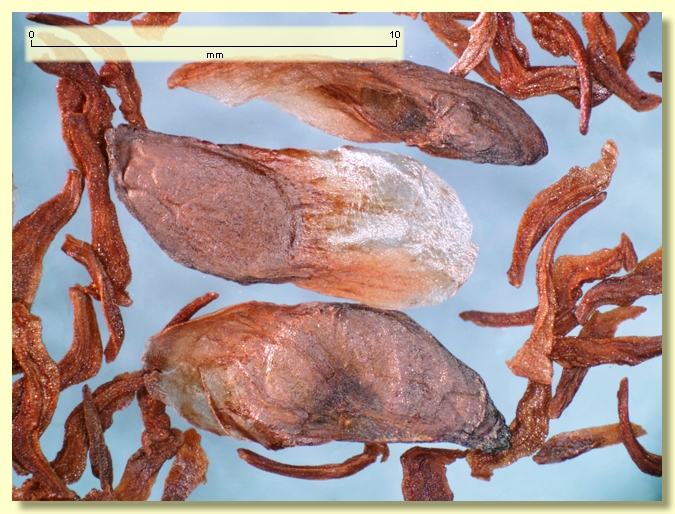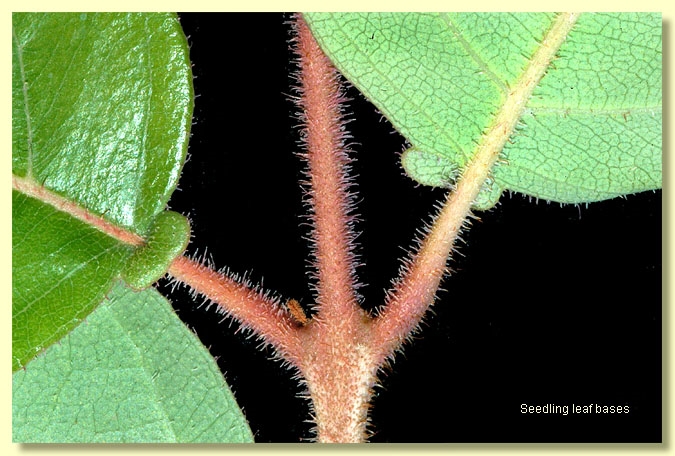Euclid - Online edition
Corymbia abergiana
Corymbia | Rufaria
Corymbia abergiana (F.Muell.) K.D.Hill & L.A.S.Johnson, Telopea 6: 244 (1995).
Eucalyptus abergiana F.Muell., Fragm. 11: 41 (1878). T: Queensland: Rockingham Bay, 24 March 1867, J.Dallachy 21; lectotype: MEL1616369; isolectotype: NSW306297; fide Bean, A.R., Telopea 12(4): 511-512 (2010).
Tree 3 m to 12 m tall. Forming a lignotuber.
Bark rough, more or less tessellated or at least deeply fissured, coarsely fibrous and brittle, extending over trunk and limbs to 5–10 cm diameter, greyish brown.
Branchlets smooth (glabrous); long oil ducts sometimes visible in the pith.
Juvenile growth (coppice or field seedlings to 50 cm): stems rounded in cross-section, setose; juvenile leaves always shortly petiolate, opposite for ca 20 nodes then becoming alternate, ovate-elliptic to elliptic-lanceolate, (4.5)8–13.5 cm long, (1.3)2–5(8) cm wide, base rounded or tapering to petiole, apex rounded or scarcely pointed, green, discolorous, glossy above, glabrous except for setae on petiole.
Adult leaves predominantly alternate but opposite and sub-opposite pairs are always present, petioles 1.3–4 cm long; blade lanceolate to broadly so, ovate intermediate leaves present at times, 8–15.2(18) cm long, 2–6.4 cm wide, base rounded or tapering to petiole, margin entire, apex finely pointed, strongly discolorous, glossy dark green above, paler below, smooth, side-veins at greater than 45° to midrib, reticulation dense to very dense, intramarginal vein present but very close to margin (more easily seen from underside when dry), oil glands small, island.
Inflorescence terminal compound, peduncles rounded, 0.5–3.8 cm long, buds in umbels of (3)7, usually sessile, very rarely with pedicels to 0.5 cm long and then most other buds in that umbel sessile. Mature buds ovoid to obovoid to broadly fusiform (1.2–1.8 cm long, 0.8–1.1 cm wide), basally green with operculum rusty and ± scurfy to warty, scar absent (both opercula shed together at flowering), operculum rounded to conical and with the thick outer (calycine) operculum incompletely fused at the apex of lobes whilst inner (petaline) operculum is much thinner and completely fused but with 4 suture lines visible on its surface, stamens inflexed, all fertile, anthers oblong, dorsifixed, versatile, dehiscing by longitudinal slits, style long and straight, stigma blunt and shortly papillose, locules 4, the ovules not arranged in clear rows on the placentae (sometimes 7 rows ± discernable). Flowers creamy white.
Fruit sessile, truncate-ovoid to barrel-shaped lacking a contracted neck but having a very thick rim, rarely slightly urceolate, (1.8)2.1–3.4 cm long, (1.5)1.8–2.6 cm wide, longer than wide, ± rusty, rim thick, flat and sometimes split but disc descending vertically from the rim, valves 4, enclosed.
Seeds brown to red-brown, 6–12(14) mm long, ellipsoidal with terminal wing, hilum ventral.
Cultivated seedlings (measured at ca node 10): cotyledons reniform; stems rounded in cross-section, setose with long bristle-glands; leaves petiolate, opposite, ovate-elliptic, 7–10.5 cm long, 1.7–5.5 cm wide, base rounded at lower nodes but from ca node 6–8 to node 14 peltate, apex rounded or bluntly pointed, green, discolorous, glossy above after node ca 7, sparsely setose on both sides especially on midrib and margins throughout seedling phase.
Flowering has been recorded in August and September.
A bloodwood tree, often stunted, endemic to tropical northern Queensland scattered on ranges from near Dinden east of Mareeba, Atherton and Herberton south to the Paluma Range, occurring as a component of open seasonally dry sclerophyll woodland or forest on ridges and slopes in shallow sandy soils over sandstone or granite. Corymbia abergiana has coarsely fissured, fibrous, almost tessellated bark over the trunk and much of the branches, a crown of glossy, strongly discolorous leaves, darker green above, paler below, and stout buds followed by large sessile truncate-ovoid fruit with a very thick rim and lacking a constriction or neck.
C. abergiana is the only bloodwood species in north-east Queensland with sessile fruit (the fruit of C. plena may be sessile but more usually have pedicels to 1 cm long – it has a more inland distribution south of Charters Towers and Hughenden). The very thick rim of the fruit of C. abergiana also easily confirms the identity of this species.
MORE ABOUT CORYMBIA
MORE ABOUT RED BLOODWOODS
Corymbia abergiana: after Ernest Georg Aberg (1823–1907). Ernest Aberg was a medical practitioner who was born and trained in Sweden but spent much of his life in Argentina where, among other pursuits, he encouraged the planting of eucalypt species.


